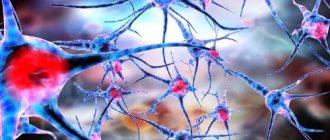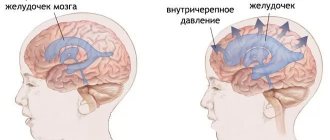A periodically occurring burning sensation in the back of the head is a serious symptom of many diseases associated with damage to cerebral blood vessels and nerve fibers. You can only get rid of a burning sensation in the back of the head with a correctly established diagnosis and effective treatment. Therefore, it is important, when such a clinical sign appears, not to engage in self-diagnosis, but to consult a neurologist.
You can make an appointment for a free appointment with this specialist at our manual therapy clinic. During the consultation, which lasts 30 minutes, the doctor will conduct an examination, make a preliminary diagnosis and give all the necessary recommendations for treatment.
Causes of burning in the back of the head
Common causes of a burning sensation in the back of the head lie in the degeneration of the cartilaginous intervertebral discs in the cervical spine. Osteochondrosis with a long course without appropriate treatment leads to the following:
- the intervertebral disc becomes thinner and loses its shock-absorbing ability;
- the radicular nerve is pinched and subjected to mechanical compression;
- the process of inflammation begins, spreading along the branches of the occipital nerve;
- increased skin sensitivity in the scalp area;
- hyperesthesia turns into a feeling of burning and pain.
The most common complication of this pathological condition is trigeminal and facial neuralgia. These diseases lead to the constant presence of severe pain attacks, which sometimes reach such intensity that the patient begins to think about suicide. It all starts with a burning sensation in the back of the head and upper neck.
Other causes of burning in the back of the head are no less dangerous to human health. This may be a deformation of the uncovertebral and facet joints, causing the neck to lose its flexibility and mobility. In this case, the ligaments, tendons and muscles surrounding the vertebrae become inflamed.
It is best to look for the reasons why the back of the head burns with the help of an experienced specialist, since already during the initial examination the doctor will be able to see characteristic changes. When palpating the spinous processes, deformations and displacements can be detected. Bone growths on the first and second vertebrae lead to disruption of the position and patency of the cerebral blood vessels. Vertebral artery syndrome may develop.
With this pathology, the reasons that the back of the head burns lie in changes in hemodynamics and blood supply to the posterior parts of the brain:
- when the cerebral blood vessels narrow, the posterior structures of the brain experience an acute deficiency of oxygen and glucose;
- a reflex narrowing of small blood vessels begins;
- secondary trophic damage to small nerve endings occurs;
- when the narrowing of cerebral blood vessels is eliminated (for example, when the position of the head is changed), active blood flow begins to the posterior structures of the brain;
- this provokes the occurrence of an acute burning sensation in the back of the head.
If the back of the head burns, the causes should be sought in the pathology of the cervical spine, cerebral blood vessels or innervation of the scalp. It is also important to exclude arterial hypertension, dislocation of the brain stem, traumatic effects and clinical manifestations of acute cerebrovascular accident.
Diagnostics
The nature of the pathology is determined by a neurologist. According to indications, an orthopedist-traumatologist, an infectious disease specialist, and other specialists are involved in the examination. The doctor finds out the time of onset, duration and nature of the pain syndrome, and identifies other symptoms. When collecting anamnesis, the doctor pays attention to possible provoking factors and the presence of chronic diseases.
Examination of the back of the head may indicate external changes (swelling, wounds, abrasions). Palpation sometimes reveals tension, muscle tightness, and enlarged lymph nodes. A neurological examination involves assessing reflexes, muscle strength, various types of sensitivity, and detecting focal disorders. To clarify the diagnosis, the following are prescribed:
- X-ray examination
. Indications for radiography of the skull are fractures of the occipital bone, for radiography of the cervical vertebrae - subluxations, spondylitis, osteochondrosis, hernias. - CT scan.
Allows you to detail the data obtained during radiography. The contrast technique displays changes in blood vessels. - Magnetic resonance imaging.
It visualizes brain tissue well and is used to study their structure, detect tumors, hematomas, areas of degeneration, and other changes. - Ultrasound methods.
Ultrasound scanning and Dopplerography make it possible to assess vascular tone, blood flow speed, and other indicators, and to form a comprehensive picture of the blood supply to the brain. - Electroencephalography.
Performed to assess the functional activity of the brain, determine the severity of cerebral dysfunction due to injuries and certain diseases - Lumbar puncture.
Performed for head injury, meningitis, encephalitis. Confirms the presence of intracranial hypertension, inflammation, bleeding. - Lab tests
. Informative for atherosclerosis, inflammatory and infectious processes, as well as somatic and endocrine diseases that provoke secondary arterial hypertension.
Examination by a neurologist
Why does the back of the head and neck burn?
Problems with a burning sensation in the back of the head are often associated with diseases of the cervical spine. Increased sensitivity of the skin provokes increased local capillary circulation. This leads to the fact that a person feels that the back of his head is burning, and additional unpleasant sensations may arise.
If the burning sensation is accompanied by the following symptoms:
- dizziness and severe muscle weakness;
- feeling of lack of air when taking a deep breath;
- nausea and vomiting;
- muscle cramps;
- weakness in arms and legs;
- Strong headache,
then you should immediately call an ambulance team. This condition can be triggered by a sharp increase in blood pressure and, as a consequence, the threat of ischemic or hemorrhagic cerebrovascular accident.
If the back of the head and neck burn strongly, then it is necessary to rule out, first of all, compression of the radicular nerves. Usually this condition accompanies long-term cervical osteochondrosis. Patients experience regular pain in the neck and collar area. There may be tingling in the upper extremities, weakening of muscle strength, etc. A sudden burning sensation may indicate that disc protrusion has developed to such an extent that compression of the radicular nerve responsible for the innervation of the occipital part of the head has occurred.
Only an experienced vertebrologist or neurologist can answer the question of why the back of the head burns and how to cope with this negative symptom. In our manual therapy clinic you can get a free initial consultation with a vertebrologist and neurologist. To do this, just call us and make an appointment at a time convenient for you.
How a patient is examined
The specifics of symptoms can clarify a lot, but this is not enough to make a diagnosis. If a problem arises, you should go to a therapist, who will conduct an initial examination and refer you to a specialized specialist. Depending on the causes of the disease, the condition can be treated by a therapist, neurologist, ophthalmologist, ENT specialist, psychologist or psychotherapist, or orthopedist.
Read also: Are head impacts dangerous in young children?
The list of diagnostic studies is selected individually. It is mandatory for the patient to donate blood and urine for general and biochemical tests. His blood pressure and temperature are measured and his fundus is examined. The most effective methods for diagnosing headaches are MRI, CT, EEG, ultrasound of the vessels of the brain and neck. If hypertension is suspected, blood pressure monitoring is indicated. In some cases, they resort to performing a lumbar puncture.
How to treat a burning sensation in the back of the head and neck
Before treating a burning sensation in the back of the head and neck, you need to establish an accurate diagnosis. It is important to understand that this is just a symptom of trouble. A clinical sign may indicate the development of the disease. By curing the disease, we relieve the symptom.
Unfortunately, in most cases, doctors in official medicine try to stop the symptom without eliminating the cause of its occurrence. As a result, patients lose precious time, during which they could completely get rid of their illness without spending a huge amount of effort, money and time on it. Instead, patients receive symptomatic treatment that quickly returns them to work and causes the intervertebral discs to deteriorate at double the rate.
What needs to be done in order to identify the cause of the burning sensation in the back of the head and eliminate it effectively, and most importantly, safely. We offer a few simple tips that, if followed, will significantly improve the quality of your life:
- do not diagnose yourself, since your assessment will be subjective - contact an experienced doctor, especially since in our manual therapy clinic you can do this for free;
- do not use painkillers on a regular basis - they destroy bone marrow cells responsible for hematopoiesis, increasing the risk of developing leukemia;
- instead of painkillers, use the technique of traction of the spinal column - this will quickly relieve pressure from the radicular nerve and you will again feel freedom of movement without burning and pain in the back, neck and back of the head;
- devote at least 15 minutes daily to special exercises for the muscles of the neck and collar area - this will help restore damaged intervertebral discs, since their cartilage tissue can only receive fluid and nutrients during muscle work;
- drink as much clean drinking water as possible per day (at least 2 liters for an average-sized adult);
- treat osteochondrosis using the most effective methods, this will eliminate the development of dangerous complications of the disease.
If you periodically experience pain in the neck and collar area, or a burning sensation in the back of the head, then you need to consult a doctor as soon as possible and conduct a series of examinations. It is advisable to take an x-ray of the cervical spine. Please note that X-rays need to be taken in several projections to identify possible antelisthesis and retrolisthesis - these two types of displacement often occur in the neck area. Due to the displacement of the vertebral body, the surrounding nerve tissues are compressed and a strong burning sensation occurs in the back of the head. Therefore, it is important to take pictures in dynamics and from different projections.
How to eliminate the burning sensation in the back of the head?
There are various ways to eliminate a burning sensation in the back of the head, and the most common among them is taking painkillers. Their pharmacological action is based on the fact that factors in the development of the inflammatory response are blocked. Due to this, swelling of the soft tissues is eliminated and the nerve fiber is released from compression. The patient experiences a fairly quick but short-term effect.
Among the more effective and long-term treatment methods include manual therapy. It is capable of starting the process of complete restoration of damaged tissues of the human musculoskeletal system. And at the same time, you will not need to take absolutely any pharmacological drugs, which eliminates the risk of harm to health.
If a burning sensation in the back of the head is a sign of osteochondrosis and accompanying complications, such as disc protrusion, hernia, vertebral artery syndrome, then the following manual therapy techniques can be used:
- traction traction of the spine – provides an opportunity to straighten the cartilage tissue of the intervertebral disc and eliminate compression of the radicular nerve;
- massage and osteopathy, enhancing the processes of microcirculation of blood and lymphatic fluid in the lesion;
- reflexology, which triggers the process of regeneration of pathologically altered tissues;
- kinesitherapy and therapeutic exercises aimed at improving the functioning of the muscular frame of the neck.
The course of treatment is developed individually. We invite you to a free initial consultation. The doctor will conduct an examination, make a diagnosis and tell you about all the treatment options for the disease you have identified.










